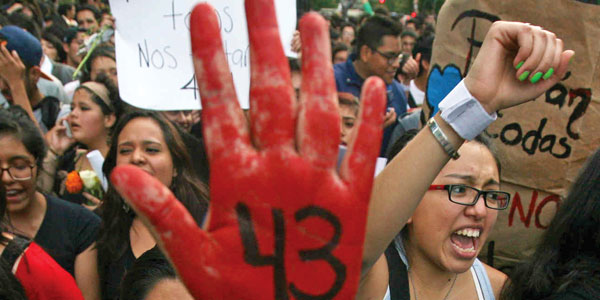“Tiempos como nunca para la chapuza, el crimen impune y la caza de brujas.”
— Joan Manuel Serrat
Esta es la historia de cómo el gobierno del presidente Enrique Peña Nieto construyó una mentira oficial sobre la desaparición de los 43 estudiantes de Ayotzinapa en septiembre del 2014. Pero la mentira ha quedado al descubierto.
Así se construyó la mentira. Tras la desaparición de los normalistas, la Procuraduría General de la República (PGR) dijo haber realizado una extensa investigación: 39 confesiones, 487 peritajes, 386 declaraciones, 153 inspecciones ministeriales y acción penal contra 99 involucrados. El procurador, Jesús Murillo Karam, aseguró “de manera contundente” a la prensa en enero del 2015 que los estudiantes habían sido incinerados en el basurero de Cocula, sus restos triturados y luego tirados a un río.
“Sin lugar a dudas los estudiantes normalistas fueron privados de su libertad, privados de su vida, incinerados y arrojados al río San Juan”, dijo el procurador Murillo, diciendo que la investigación se basó en más de 60 mil fragmentos de restos óseos. “Esa es la verdad histórica de los hechos.”
No, esa era la versión falseada e incompleta que el procurador y el gobierno mexicano nos trataron de vender. Según cinco expertos de la Comisión Interamericana de Derechos Humanos, el informe del gobierno mexicano tiene muchos errores.
El informe del gobierno de México “es una especulación”, me dijo el peruano José Torero, uno de los cinco expertos y jefe del departamento de ingeniería civil de la Universidad de Queensland, Australia. “La evidencia material, en el fondo, no existe.”
Torero asegura que los 43 normalistas no fueron incinerados en el basurero de Cocula, como decía el procurador. “Para haber tenido un incendio de esa magnitud, habrían tenido daños generalizados en toda la vegetación aledaña y esos daños no existen”, concluyó. “Por otro lado, los huesos que se encontraban en el basurero de Cocula están incinerados a un nivel de calcinación que requiere un fuego externo. … No hubo la posibilidad de tener tal incendio.”
La hipótesis de que los jóvenes fueron incinerados en ese basurero fue totalmente desmentida por los expertos de la CIDH. También es falsa la aseveración del ahora ex procurador Murillo Karam de que no había “ni una sola evidencia, ni una sola, de la participación del ejército.”
El ejército mexicano supo en todo momento lo que estaba pasando, me dijo José Miguel Vivanco, de Human Rights Watch. “Está documentado” que el ejército y la Policía Federal “estuvieron plenamente informados de lo que estaba pasando en tiempo real” gracias al C4 (un sistema central de comunicaciones de acceso restringido de las fuerzas de seguridad).
Además, me dice Vivanco, “fueron agentes de la Policía Federal los que interceptaron un quinto autobús donde iba un grupo de estudiantes que lograron huir y todos salvaron la vida. Ese quinto autobús luego desaparece y no quedaron rastros de su paradero en la investigación de la PGR.”
Es decir, las dos conclusiones principales del informe del gobierno sobre la desaparición de los estudiantes — que fueron incinerados en un basurero y que el ejército y la Policía Federal no tuvieron nada que ver — son falsas y forman parte de la mentira oficial.
¿Por qué el gobierno de Peña Niego ocultó y encubrió en su informe la participación del ejército? Imposible de saber. Son los juegos del poder. Pero ¿por qué inventarse la teoría de la incineración de los estudiantes?
Sólo ellos lo saben. Primero, quizás, para “superar” el problema y quitárselo de encima. La desaparición de los normalistas de Ayotzinapa terminó con la imagen positiva que Peña Nieto estaba cultivando en el mundo. Y segundo, tal vez, para culpar a grupos violentos del incidente y ocultar la incompetencia de su gobierno frente a la inseguridad y el crimen.
Es muy grave que hoy, todavía, no sepamos donde están los 43 jóvenes. Pero hay algo aún más grave: erigir una mentira oficial es el acto más cruel e inhumano que se puede concebir frente a los padres y familiares de los estudiantes desaparecidos.
(Aquí está la entrevista de televisión con el experto José Torero: youtu.be/HhtzrIQFxNQ. Hasta el momento de escribir esta columna, nadie del gobierno mexicano le había hablado por teléfono. «Estoy muy apenado de que, a pesar de que es una investigación independiente, la PGR la ha convertido en un circo mediático», me dijo Torero. «Debería ser una discusión técnica; si quieren aclarar esto, yo encantado de sentarme con expertos.” Si de verdad el gobierno mexicano quiere saber qué pasó con los 43 estudiantes ¿por qué no le hablan?)
In Mexico, an Official Lie
By Jorge Ramos
“Times like no other for botched jobs, unpunished crimes and witch hunts.”
— Joan Manuel Serrat
After 43 Mexican college students from Ayotzinapa went missing a year ago, President Enrique Peña Nieto’s administration started telling an official lie about their disappearance. Today, that lie has been exposed.
On Sept. 26, 2014, the students, who all attended a rural teachers’ college, got on five buses and headed to Iguala. Shortly afterward, they went missing and were presumed dead. Months later, following what was characterized as an extensive investigation, the Attorney General’s office announced that it had obtained 39 confessions, conducted 487 inspections, recorded 386 testimonies and initiated legal action against 99 people who were allegedly involved in the students’ deaths.
Last January, then-Attorney General Jesús Murillo Karam announced at a press conference that the bodies of the students had been incinerated in a landfill in Cocula, and their ashes dumped in a nearby river. “There is no doubt that the students were captured, murdered, incinerated and dumped in the San Juan River,” Murillo Karam claimed, noting that thousands of bone fragments were recovered. “That’s the historical truth.”
Unfortunately, this “truth” has proven to be a rigged, incomplete version of events that the Mexican government has peddled to the world.
According to five experts appointed by the Inter-American Commission for Human Rights, the Mexican government’s official report contains many mistakes. In fact, José Torero, one of those five experts, told me recently that the Mexican government’s version is “pure speculation.” Torero, who is from Peru and is the head of the civil engineering department at Australia’s University of Queensland, said that “in substance, there is no material evidence.”
For instance, Torero said, the remains of the 43 students could not have been incinerated at the Cocula landfill, as the government asserted. “Had there been a fire of that scale, there would be generalized damage to the surrounding vegetation and the rest of the garbage, and there was no such damage,” he told me. “Besides, the bones found in the Cocula landfill were incinerated to a degree that requires an external fire. … According to witness testimony, there was no possibility for a fire of that scale.”
The Inter-American Commission for Human Rights also concluded that the assertion by Murillo Karam that there was “not a single evidence, not even one, of the army’s involvement” in the students’ disappearances is also false.
According to José Miguel Vivanco, executive director, Americas division, of Human Rights Watch, officials from the Mexican army actually knew from the beginning what was happening. Vivanco contends that army and federal police officials “were thoroughly informed of what was happening in real time,” through a central communications system for the security forces. Vivanco also told me in an interview that, “federal police intercepted the fifth bus, with a group of students who managed to escape and save their lives. That fifth bus later disappeared, and there are no traces of its whereabouts in the investigation.”
So two primary conclusions from the Mexican government’s report — that the students’ remains were incinerated and that the army and federal police had nothing to do with their disappearance — both appear to be false and components of an official lie.
Why did Peña Nieto’s administration invent these stories? Perhaps they wanted to get rid of this problem once and for all; the tragedy stymied Peña Nieto’s efforts at cultivating a positive image around the world. Or, maybe the administration simply wanted to place the blame for the students’ disappearance on violent drug cartels in Mexico in order to hide the government’s incompetence when it comes to dealing with crime.
Nevertheless, more than a year has passed, and we still don’t know what happened to these 43 young men. And while the parents and friends of the missing students try to face life without their loved ones, their government is still not interested in finding out what actually happened to them. Fabricating an official lie seems like yet another cruel and inhumane act perpetrated against the families of the missing students.
(Here’s my interview with José Torero: youtu.be/HhtzrIQFxNQ. As of press time, nobody from the Mexican government has contacted him, preferring instead to criticize his findings in the media. “If they want to clarify anything, I’d be delighted to sit down with their experts.” If officials really want to know what happened to the 43 students, why don’t they give Torero a call?)










